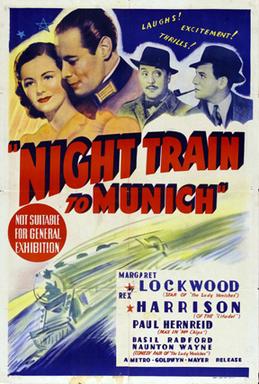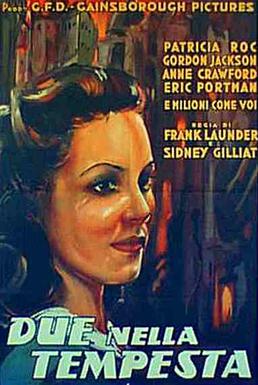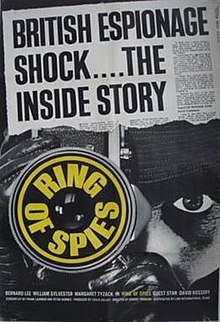
Cold War espionage describes the intelligence gathering activities during the Cold War between the Western allies and the Eastern Bloc. Both relied on a wide variety of military and civilian agencies in this pursuit.
Sidney Gilliat was an English film director, producer and writer.

The Great St. Trinian's Train Robbery is a British comedy film, directed by Frank Launder and Sidney Gilliat, written by Sidney and Leslie Gilliat, and released on 4 April 1966. It is the last of the original series of films based on the St Trinian's School set of images and comics, and the only one to be produced in colour. The film stars a selection of actors from previous films in the series, including George Cole, Richard Wattis, Eric Barker, Michael Ripper, and Raymond Huntley, alongside Frankie Howerd, Reg Varney, Dora Bryan, and the voice of Stratford Johns.

William R. Sylvester was an American actor, chiefly known for his film and television work in the United Kingdom. A graduate of the Royal Academy of Dramatic Art, he was a star of British B-movies in the 1950s and 1960s, but gained widespread recognition for his role as Dr. Heywood Floyd in the landmark science-fiction film 2001: A Space Odyssey (1968).
Frank Launder was a British writer, film director and producer, who made more than 40 films, many of them in collaboration with Sidney Gilliat.

Morris Cohen, also known by his alias Peter Kroger, was an American convicted of espionage for the Soviet Union. His wife Lona was also an agent. They became spies because of their communist beliefs.

Lona Cohen, born Leontine Theresa Petka, also known as Helen Kroger, was an American who spied for the Soviet Union. She is known for her role in smuggling atomic bomb diagrams out of Los Alamos. She was a communist activist before marrying Morris Cohen. The couple became spies because of their communist beliefs.

Night Train to Munich is a 1940 British thriller film directed by Carol Reed and starring Margaret Lockwood and Rex Harrison. Written by Sidney Gilliat and Frank Launder, based on the 1939 short story Report on a Fugitive by Gordon Wellesley, the film is about an inventor and his daughter who are kidnapped by the Gestapo after the Nazis march into Prague in the prelude to the Second World War. A British secret service agent follows them, disguised as a senior German army officer pretending to woo the daughter over to the Nazi cause.

The Portland spy ring was an espionage group active in the UK between 1953 and 1961. It comprised five people who obtained classified research documents from the Admiralty Underwater Weapons Establishment (AUWE) on the Isle of Portland, Dorset, and passed them to the Soviet Union.
Harry Frederick Houghton was a British Naval SNCO and a spy for the Polish People's Republic and the Soviet Union during the Cold War. He was a member of the Portland Spy Ring.
Ethel Elizabeth Gee, nicknamed "Bunty", was an Englishwoman who helped her lover spy for the Soviet Union. She was a member of the Portland Spy Ring.

Konon Trofimovich Molody was a Soviet intelligence officer, known in the West as Gordon Arnold Lonsdale. Posing as a Canadian businessman during the Cold War, he was a non-official (illegal) KGB intelligence agent and the mastermind of the Portland Spy Ring, which operated in Britain from the late 1950s until 1961.

Geordie is a 1955 British film directed and co-produced by Frank Launder, with Bill Travers in the title role as a Scotsman who becomes an athlete and competes at the 1956 Summer Olympics in Melbourne.

British Lion Films is a film production and distribution company active under several forms since 1919. Originally known as British Lion Film Corporation Ltd, it entered receivership on 1 June 1954. From 29 January 1955 to 1976, the company was known as British Lion Films Ltd, and was a pure distribution company.

Millions Like Us is a 1943 British propaganda film, showing life in a wartime aircraft factory in documentary detail. It stars Patricia Roc, Gordon Jackson, Anne Crawford, Basil Radford, Naunton Wayne, Moore Marriott and Eric Portman.

I See a Dark Stranger – released as The Adventuress in the United States – is a 1946 British World War II spy film with touches of light comedy, starring Deborah Kerr and Trevor Howard. It was written and produced by the team of Frank Launder and Sidney Gilliat, with Launder directing.
Anthony Cave Brown was a British journalist, espionage non-fiction writer, and historian.

Endless Night is a 1972 British horror-mystery film directed by Sidney Gilliat and starring Hayley Mills, Britt Ekland, Per Oscarsson, Hywel Bennett, and George Sanders. Based on the 1967 novel Endless Night by Agatha Christie, the plot follows a newlywed couple who feel threatened after building their dream home on cursed land.
Robert Tronson was an English film and television director, born in Chilmark, Wiltshire. Educated at Churcher's College in Hampshire, followed by the Royal Naval College, Dartmouth, he served with the Royal Navy from 1941. After leaving the service at the end of the Second World War he determined to become a writer, but soon joined the BBC, where he produced children's television programmes. In 1955 he joined Associated-Rediffusion, and by the end of the decade he was working on television drama serials. From the 1960s onwards he worked as a freelance director in a career spanning almost 50 years. His final television credits were for directing five episodes of Hetty Wainthropp Investigates for the BBC, between 1996 and 1998.
Leslie Gilliat was a British film producer and production manager. He was the younger brother of director Sidney Gilliat, with whom he worked on a number of films for British Lion Films.












